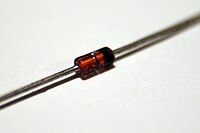
Photo from wikipedia
Stability issue is one of the major concerns that limit emergent perovskite light-emitting diodes (PeLEDs) techniques. Generally, ion migration is considered as the most important origin of PeLEDs degradation. In… Click to show full abstract
Stability issue is one of the major concerns that limit emergent perovskite light-emitting diodes (PeLEDs) techniques. Generally, ion migration is considered as the most important origin of PeLEDs degradation. In this work, an all-inorganic device architecture, LiF/perovskite/LiF/ZnS/ZnSe, is proposed to address this imperative problem. The inorganic (Cs1-xRbx)(1-)(y)K(y)PbBr(3)perovskite is optimized with achieving a photoluminescence quantum yield of 67%. Depth profile analysis of X-ray photoelectron spectroscopy indicates that the LiF/perovskite/LiF structure and the ZnS/ZnSe cascade electron transport layers significantly suppress the electric-field-induced ion migrations of the perovskite layers, and impede the diffusion of metallic atoms from cathode into perovskites. The as-prepared PeLEDs display excellent shelf stability (maintaining 90% of the initial external quantum efficiency [EQE] after 264 h) and operational stability (half-lifetime of about 255 h at an initial luminance of 120 cd m(-2)). The devices also exhibit a maximum brightness of 15 6155 cd m(-2)and an EQE of 11.05%.
Journal Title: Advanced Functional Materials
Year Published: 2020
Link to full text (if available)
Share on Social Media: Sign Up to like & get
recommendations!